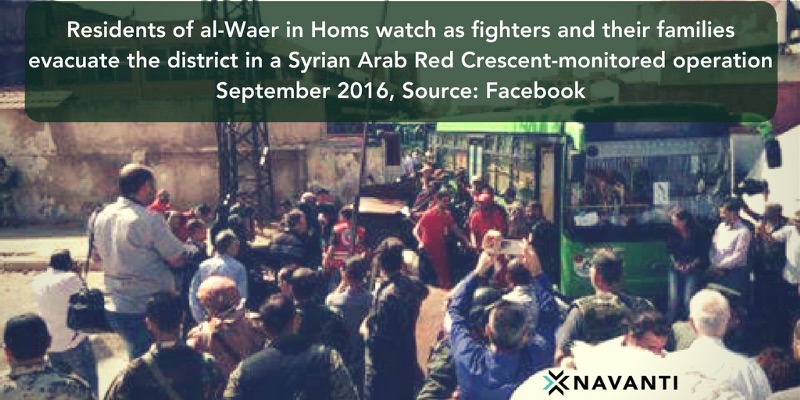This is the second in a two-part series examining iterative negotiations in al-Waer, the final remaining opposition-held neighborhood in Homs, Syria. Navanti Researchers on the ground in al-Waer conducted interviews and reporting in the area, gauging local views toward the ongoing negotiations. The first piece in this series provided an overview of how negotiations in al-Waer have evolved over time. This second piece will explore how the regime implemented a strategy of “kneel and starve” in al-Waer and its toll on the civilian population.

Since 2012 the regime has implemented a strategy of “kneel and starve,” or subjecting civilian populations to siege and low-level violence, across the country in order to erode local support for rebel groups and eventually secure their surrender.
It used this strategy to great effect in al-Waer, considerably whittling down opposition demands from the first truce agreement signed in December 2015, to the second in August 2016, as detailed in part one of this series. Here, we explore the material toll “kneel and starve” has taken on the civilian population of al-Waer, and how it has caused many to give up hope and turn to surrender as their only viable option.
On the ground, the regime’s “kneel or starve” strategy means that checkpoints operated primarily by State Security Forces around al-Waer prevent the free entry of most essential goods, including food and medicine. As a result, residents have become accustomed to getting by on a single meal a day, an activist from al-Waer told us over email.
data-animation-override>
““Some families had some seeds that they planted in their gardens, so they could grow things the regime had forbidden — plants and food. But these yielded small quantities that were only enough for some individuals,” he said.”
As early as 2015, many residents clung to life by searching for lettuce leaves, or bits of bread in the trash, reported pro-opposition SkyNews Arabia. Others took to buying barley and grains that were made for animal consumption.
Starvation had its intended effect. After years of resistance, a sizeable portion of al-Waer’s civilian population now supports a truce deal that would end their suffering, even if it is akin to surrender.
data-animation-override>
““I support the truce that was agreed upon so we can return to our normal lives and so the bombing stops, which has claimed victims and destroyed houses and infrastructure,” a former cab driver who now collects and sells firewood, told us over email.”
data-animation-override>
““The fighting needs to be stopped by any means possible, with the goal of reconciliation,” he added.”
To be sure, not all residents of al-Waer feel the same way. Many have lost relatives, friends, or homes to regime violence and cannot stomach the idea of ending the fight.
data-animation-override>
““With the difficult humanitarian situation, social conditions, and military escalation, people are split between those who want revolutionary activity to continue and those who want a peaceful solution,” said the activist.”
In the first category is a carpenter who considers the regime an untrustworthy negotiating partner, and the revolution a cause too just to abandon.
data-animation-override>
““I don’t think I’ll ever be able to live side by side with people who supported a murderous regime, one that killed our children, women, and young men and displaced our families,” he told Navanti.”
But with the battle for Aleppo settled and the regime making rapid gains around Damascus, the military scales in Syria have now decisively swung in its favor. Al-Waer residents used to hold out hope that rebels from northern Homs would sweep south, break the siege and rescue them. They do not harbor any such illusions now.
data-animation-override>
““We’re a peaceful people, we love safety and calm,” said the former taxi driver.”

